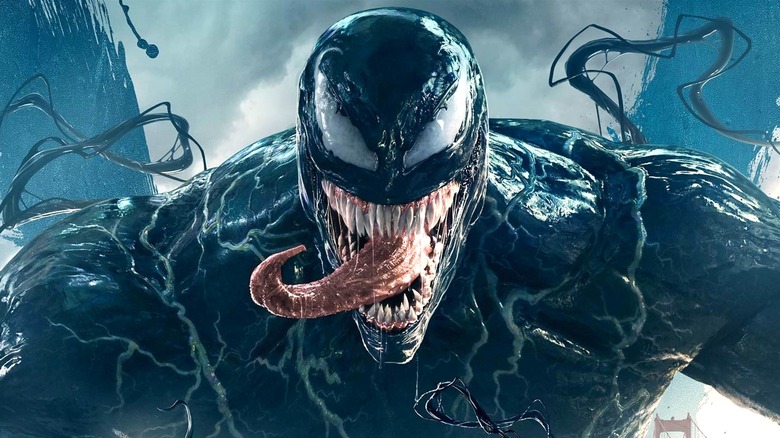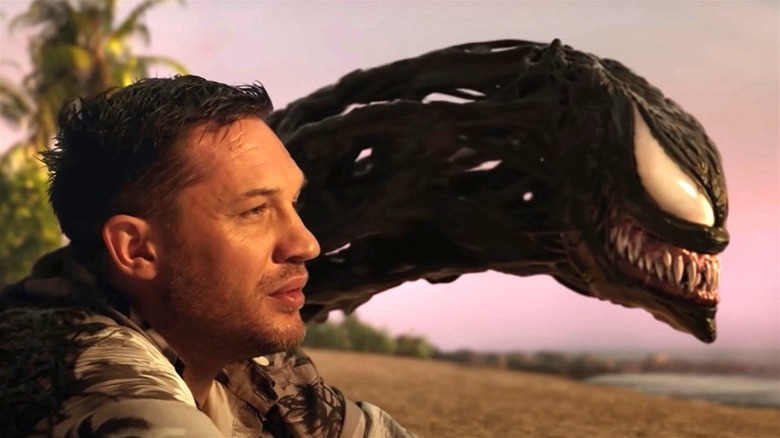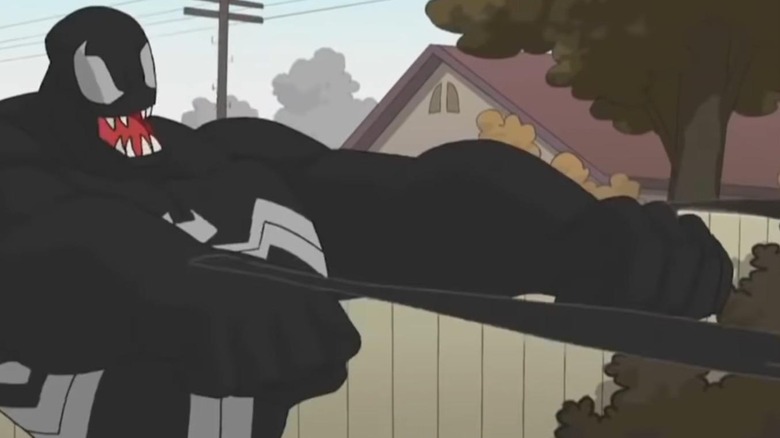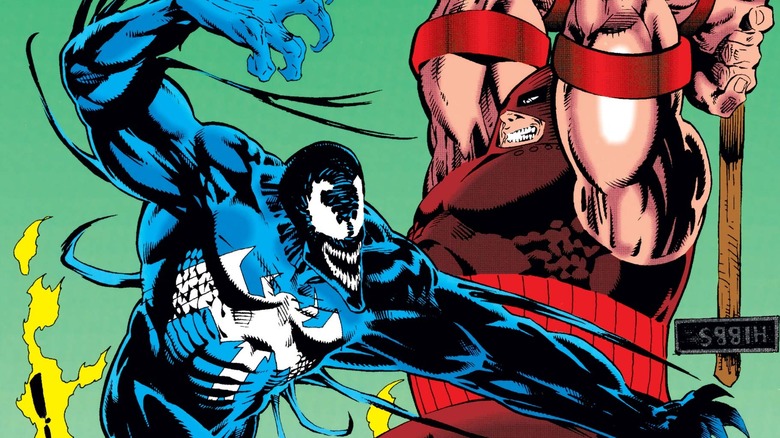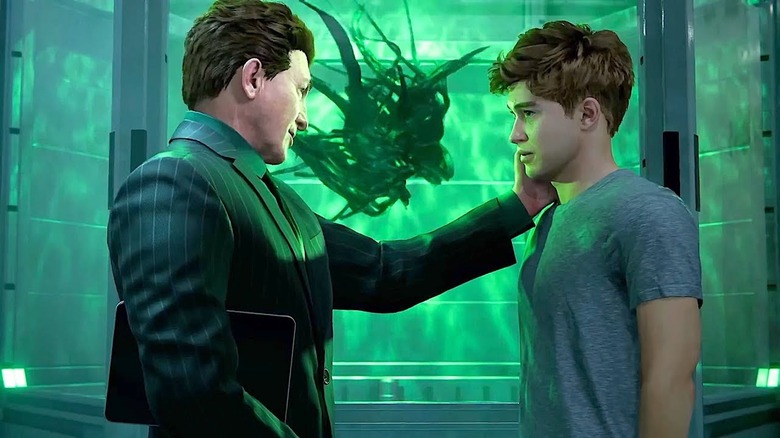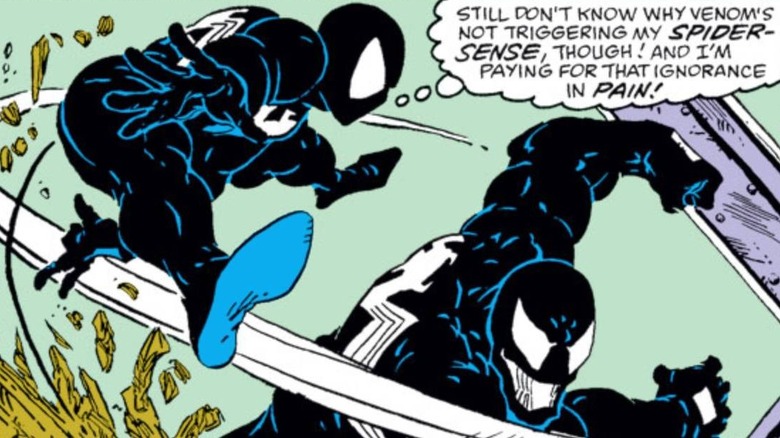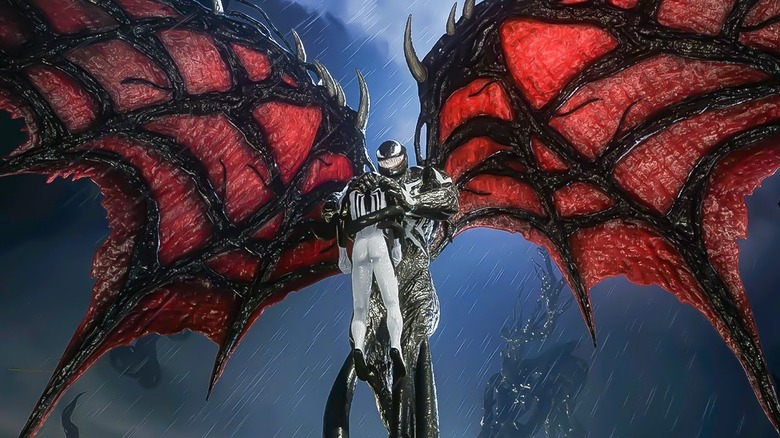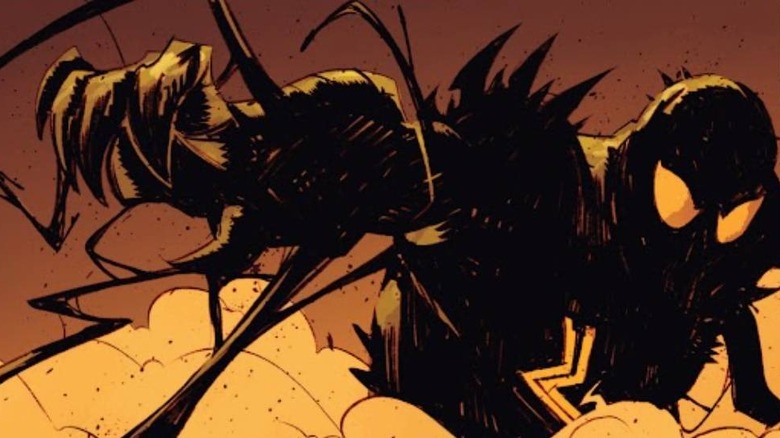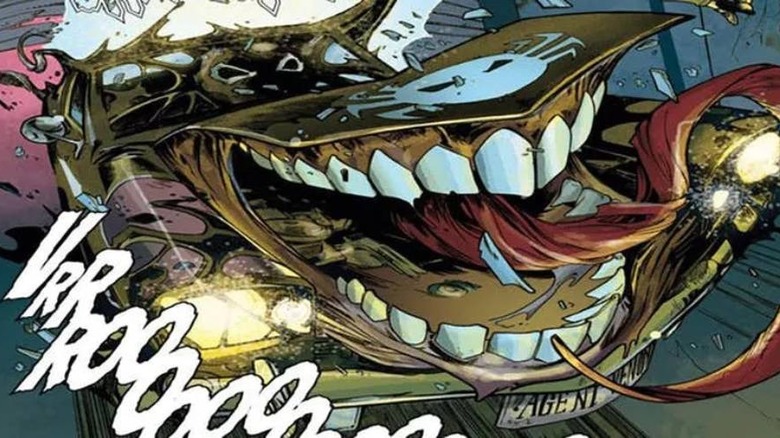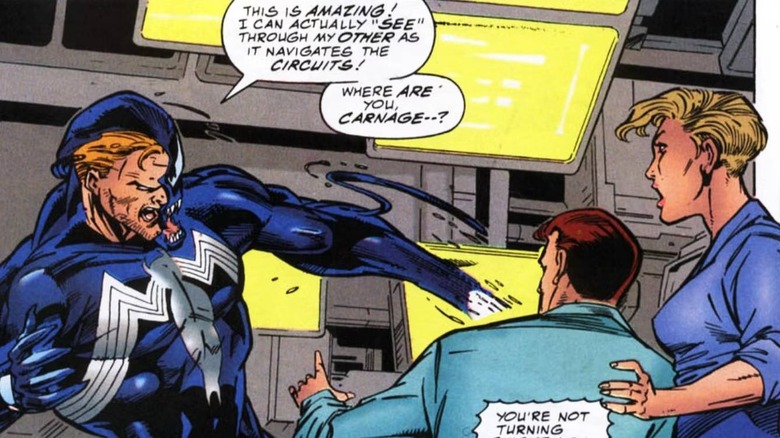All Of Venom's Powers, Explained
Venom began life in Marvel Comics as Peter Parker's black alien suit, giving him a fresh new look but a host of other problems. The symbiote wouldn't be formally introduced until the last page of "The Amazing Spider-Man" #299 from David Michelinie and Todd McFarlane. It ultimately ditched Peter Parker and fused with intrepid reporter Eddie Brock, thus becoming the lethal protector known as Venom.
Venom's done some truly terrible things over the years, but the character has also been painted as more of an anti-hero at times. This is the case in the "Venom" film trilogy in which Tom Hardy plays Eddie Brock, the human most associated with Venom in pop culture. Brock frequently gets wrapped up in larger-than-life conflicts with even more sinister symbiotes out to cause havoc. Fortunately, Venom's not short on powers to help Brock through any fight.
As tends to be the case with most superheroes (and villains), Venom has a collection of powers across the various comics, TV shows, and movies that it's appeared in. Some come pretty standard with the character, while others vary depending on the iteration. After all, Eddie Brock isn't the only person Venom's bonded with. In fact, the symbiote has merged with plenty of Marvel heroes: Thor, Hulk, and even Groot have hosted it at various points. In case you need a refresher on what makes Venom so formidable as an opponent, here are some of its most notable abilities.
Symbiote Biology
Before diving headfirst into Venom's skillset, we should quickly dissect what exactly Venom can do all on its own. When not bonded to a host, Venom is essentially a mass of goo that's capable of moving on its own by creating tendrils until it latches onto a host. Symbiotes are typically drawn to strong emotions, particularly aggression, as Dr. Curt Connors (Dylan Baker) points out in "Spider-Man 3."
Once the symbiote has bonded to someone, it can take on its physical attributes, creating a human-like appearance with a head, torso, and appendages. Of course, this aesthetic can change, as the "Venom: The Last Dance" promotional materials show Venom taking on the looks of a horse and fish after bonding with those.
Venom is ultimately a shapeshifter and can take on various forms. It even has camouflage to blend in with its surroundings, whether that's clothing on a host's body or even plant life — it's been known to use trees as camouflage. Once bonded to a host, Venom can increase their overall strength while still retaining its more fluid biology. One "Venom 3" trailer teased a power only true Marvel fans got when Venom almost developed wings before turning into a parachute, showing how Venom still retains its malleable makeup even when there's a human in the mix.
Parasitic Inheritance
Many of the powers people associate with Venom are actually ones that it has inherited from various hosts, most notably Spider-Man. In certain adaptations, Venom can climb up walls and shoot its own webs, but that's because when it bonded with Peter Parker initially, it gained access to his genetic code. Later, when Venom bonded with Eddie Brock, those powers remained, which are sometimes useful but come with their own drawbacks. For example, in "The Amazing Spider-Man" #300, Peter's able to defeat Venom once he realizes that it makes webbing using its own symbiotic material as opposed to a separate webbing material. The more Venom webs, the weaker its bond with Eddie becomes, and Spider-Man uses this to his advantage.
It may have taken some time for Venom/Eddie to learn the ropes, but the ability to enhance a host's powers and retain them across bodies makes Venom one of Spider-Man's most powerful villains. This parasitic inheritance is the reason why the character will forever remain connected to Spider-Man. Gaining access to a host's genetic code means Venom can also access their memories, which is how Venom — and, by extension, Eddie Brock — knows that Peter Parker is Spider-Man. With access to a Multiversal hive mind (more on that later), this could serve as the explanation for why Venom is so interested in Peter Parker in the post credits scene for "Venom: Let There Be Carnage."
Durability, Strength, and Stamina
As with many superpowered characters, Venom has enhanced strength, durability, and stamina; however, the exact extent of those powers can vary greatly. Generally, it's accepted that Venom increases a host's strength to be able to lift up to 40 tons. This allows Venom to be on equal footing with Spider-Man during fights, and the symbiote has more than held its own against many other worthy adversaries.
Despite Juggernaut being strength incarnate in the comics, Venom's been able to defeat him. Additionally, Venom went toe-to-toe with Superman in the DC and Marvel crossover event "All Access" from Ron Marz, Bill Oakley, Jackson Guice, Josef Rubinstein, and Lee Loughridge. Venom even managed to stand its ground for much of the fight, requiring Superman to team up with Spider-Man to take the symbiote down.
Power scaling is often the bane of many comic book fans' existences. After all, Venom has certainly lost plenty of fights, but it seems to largely come down to how much a character knows about Venom's weaknesses, such as fire and high-frequency noises. Of course, the symbiote is also aided by the fact it's incredibly durable, easily bypassing bullets without any damage occurring to the host.
Healing Factor
When Venom and/or its host sustain damage in a fight, the symbiote can help heal all parties involved quicker than a normal human body would. However, that only scratches the surface of what Venom can heal. There have been many storylines where Venom heals illnesses and diseases in its host. More recently, this type of storyline was used in the "Spider-Man 2" video game, in which Harry Osborn has Oshtoran Syndrome.
Harry's father begins experiments to bond Harry with the symbiote, and initially, Harry appears all better. He even joins Spider-Man on some missions with enhanced strength. Of course, it's not long until the symbiote begins corrupting Harry, but he's resistant to the idea of separating from Venom out of fear the disease will make him weak once more. While Venom offers sheer power, its ability to regenerate is often one of the more enticing aspects and a big reason why hosts can be hesitant to surrender the symbiote. Flash Thompson bonded with Venom in the comics, becoming Agent Anti-Venom, after losing his legs in the Iraq War with the prospect of having new legs via Venom's biomass.
Immunity to Spider-Sense
Another reason why Venom is such a deadly foe for Spider-Man is that the superhero's Spider-Sense doesn't work on him. The reason for this comes down to that initial bonding. Spider-Man doesn't register the symbiote as a foe since it was part of his body for an extended period of time, so he doesn't automatically know when Venom is in the vicinity. Combined with Venom's camouflaging, it's pretty easy for Venom to get the jump on Peter Parker: He has no idea when another attack is coming, putting him at an immediate disadvantage.
However, this suggests that Venom would trigger the Spider-Sense of any other spider-powered individuals, like Miles Morales, provided they didn't bond with him. Interestingly, Ben Reilly, aka Scarlet Spider, does sense when Venom is nearby when they've fought before in the comics. This is despite the fact that Ben is Peter Parker's clone, so one might surmise that Venom would also be immune to his Spidey-Sense. At the end of the day, the less time spent thinking about the Clone Saga, the better.
It usually appears as though Venom didn't inherit any sort of Spider-Sense from Peter, although it does typically display good cognition when it comes to nearby threats. This is likely due to the symbiote's alien origin and its connection with others of its kind — if they're close by, Venom can tell.
Telepathy and Access to the Hive Mind
Venom is able to communicate with its host telepathically. There's essentially two minds in one body, which provides Venom with an additional layer of defense when going up against telepaths. For example, in "X-Men Blue Annual" #1 from Cullen Bunn, Edgar Salazar, and Matt Milla, Venom fights the X-Men. Jean Grey attempts to incapacitate Venom, but with two minds instead of one, it takes her longer than usual to get the job done.
The primary communication power that makes Venom such a significant threat is the symbiote hive mind. Venom can access information about other symbiotes from its home world and even gain details about its species' history. This is all under the surveyorship of Knull, the creator of the symbiotes. He linked them all through a hive mind, making himself the nexus that controls them all. This hive mind has even been shown to transcend the Multiverse, which is likely how Venom in the Tom Hardy films knows about Spider-Man even though it never merged with a Peter Parker in that particular universe.
But potential voices don't end there. In "Venom: Space Knight" #2 from Robbie Thompson and Ariel Olivetti, Venom gains the power of "Cosmos Communion," where Flash Thompson and Venom become Agents of the Cosmos with the ability to hear those in need across space. As Myntril explains it to Venom, "Agents are tied to the Cosmos itself. When we hear voices cry out... we answer." That's a lot of voices all in one head.
Advanced Intelligence
One of the untold truths about Venom is that the character is actually quite intelligent. Maybe that's not so surprising given its penchant for eating brains, but Venom is so much more than a rage monster that gets upset after losing all of Eddie Brock's money at a slot machine. There are numerous ways in which Venom's intelligence manifests itself.
Venom displayed a photographic memory in "Venom: Let There Be Carnage." After just a few glimpses of the drawings in Cletus Kasady's (Woody Harrelson) cell, Venom was able to recreate them later. This intelligence extends beyond what the symbiote might've gotten through previous hosts (like Peter Parker in some cases), as Venom has access to billions of years' worth of knowledge through the symbiote hive mind.
Venom is also an adept tactician in the heat of battle. "Let There Be Carnage" shows this in action when Venom fights Carnage and Shriek (Naomie Harris) by knocking Shriek off its platform so that its sonic blasts strike Carnage. Venom's even proven adept at picking up other Earth languages, like speaking Mandarin to Mrs. Chen (Peggy Lu).
Constituent Matter Regeneration and Manipulation
Venom can manipulate its very being to have pretty much whatever appendages it wants. This includes long tendrils and even wings. When Venom bonded with Mac Gargan, it used its biomass to create a tail, similar to the one Gargan has when he's dressed in his Scorpion get-up. Newer iterations of the character have seen Venom basically create weapons through its biomass, like turning its arms into blades and axes.
Agent Venom has even been shown to throw the biomass and make it look like various knives that can still shred an opponent, which can remerge back into Venom's body, and the symbiote has been known to grow venomous fangs that are able to disable combatants. It would seem that most of the time, Venom simply prefers to use tendrils to fight opponents, whereas Carnage prefers opting for more bladed appendages. But Venom knows when to bring out the big guns and when to get defensive, even transforming itself into armor on occasion.
Environmental Adaptation
It's hard to kill Venom, and not just in combat. The symbiote can survive in practically any environment, including the far reaches of space. When Venom's traveling with Flash Thompson in "Venom: Space Knight," their ship gets blown out of space, and they crash land on an alien world. Not only is Venom able to survive the oxygen-less environment of space until they wind up on a planet, but it's able to surround Flash so that he survives, too.
The symbiote can also protect itself and its host from noxious gasses and even create a filtration system when underwater so that the host can continue to breathe. And these powers can extend to others outside of the host, as shown in "Venom" Vol. 2 #38. Jack O'Lantern unleashes a poisonous gas to try to kill Andi, a student at the school Flash Thompson works at. To save her, Flash extends a portion of the symbiote so that she can continue to breathe in the gas. However, part of it bonds with her to transform her into Mania, a major symbiote in Marvel Comics with more backstory than you may realize.
Morphomerge
Venom can merge with humans and animals, though some fans may not realize that Venom can also interact with inanimate objects. This was delightfully displayed in "Venom" Vol. 2 #36, with Flash Thompson once again testing the limits of what the symbiote can do. As Flash gives chase to a criminal, he stumbles upon an abandoned car. He's actually able to merge with the vehicle via Venom, which then becomes a real hot rod, complete with Venom's giant tongue protruding out of the hood. The license plate even reads "Agent Venom" because the symbiote is nothing if not a showman.
The internet lost its collective mind when Venom bonded to a horse in a "Venom: The Last Dance" trailer, with superhero fans on Reddit praising the design. "I love how no matter your thoughts on any aspect of Sony, Marvel, Disney, Fox (rip) everyone agrees the symbiotic horse is pretty cool," said u/scruffyduffy23 wrote, and u/n3rdsm4sh3r said, "I would love to see a Budweiser activation with venomized horses." If the creatives behind the scenes at Sony need to up the ante for any potential future installments, a Venom car is always on the table.
Digital Immersion
Speaking of powers that are unlikely to make it to the big screen any time soon, Venom actually has the ability to enter the internet. Or at least it did in one particular issue — "Venom: Carnage Unleashed" #4. This crazy installment comes from writer Larry Hama and penciller Andrew Wildman. In it, Venom takes its beef with Carnage into the digital realm. It all begins when a video game company called Extreme Violence Video Games (because who has time for subtlety?) designs a game about Carnage. The company gives Carnage a copy of it and a computer to test out.
Carnage isn't happy about the royalties situation, so it escapes to confront the game's creators. It soon discovers that symbiotes can transfer into the internet and kill people remotely. Venom has the same ability, so it tracks Carnage into cyberspace, where they do battle once more. "Venom: Carnage Unleashed" #4, which came out in 1995, is definitely a product of its time with a storyline about violent video games and a complete misunderstanding of how the internet works. However, digital immersion is technically one of Venom's powers. The only question is which screenwriter has the guts to put it into a movie.
